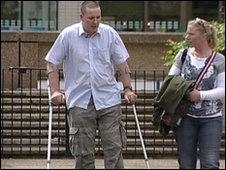Hope over pain relief implant which uses Wii technology
- Published
A new type of pain relief implant for chronic back and leg disorders which uses Wii-style technology has been used for the first time in Britain.
Doctors at Guy's and St Thomas' Hospital in London installed the neurostimulator in a patient left in pain from an accident.
The device uses motion-sensing technology to adjust the level of pain relief being administered.
The patient, Robert Mason, 35, from Berkshire, said he was delighted.
Neurostimulators have already been approved for use in the NHS by the health watchdog NICE.
Wires implanted in the spinal cord deliver mild electrical signals which helps to mask the body's pain signals with a tingling sensation.
But when a patient moves position they frequently require adjustment to vary the level of stimulation, otherwise patients can end up with a surge of pain.
Constant pain
The new device has a motion sensor, similar to those found in a Nintendo Wii or iPhone. It uses the force and direction of gravity to sense the patient's position.
Up until the treatment, Mr Mason had endured severe and constant pain in his back and left leg ever since an accident eight years ago. Nothing, even the most powerful pain-killers, had worked.
"My pain has been a constant eight out of 10, like the worst toothache you can imagine. I get about two hours sleep a night at best, and then only in short bursts."

Robert Mason said he was delighted with the results
But the father-of-three, who is the first patient in the UK to have a neurostimulator with an in-built motion sensor, said he was delighted with the results.
"It's brilliant. Now I can have the kids sitting on my lap, whereas before I was wriggling in pain. I feel like a proper parent again. I am looking forward to getting four hours straight sleep at night and hoping to get back to work."
Mr Mason still feels pain, but said the neurostimulator had reduced it from an eight out of 10 to four.
Dr Adnan Al-Kaisy, a pain management consultant at Guy's and St Thomas' Hospital, said it should significantly improve the quality of life for many patients.
"We've been waiting for this device for a long time. It's a breakthrough and will make a major difference, by providing accurate stimulation to these patients."
Dr Joan Hestor, from the British Pain Society, added: "The new device sounds wonderful. To allow patients better movement would be a significant advance.
"Neurostimulators are suitable only for a minority of patients with unresolved severe back and leg pain, but potentially such devices could help thousands of people each year."